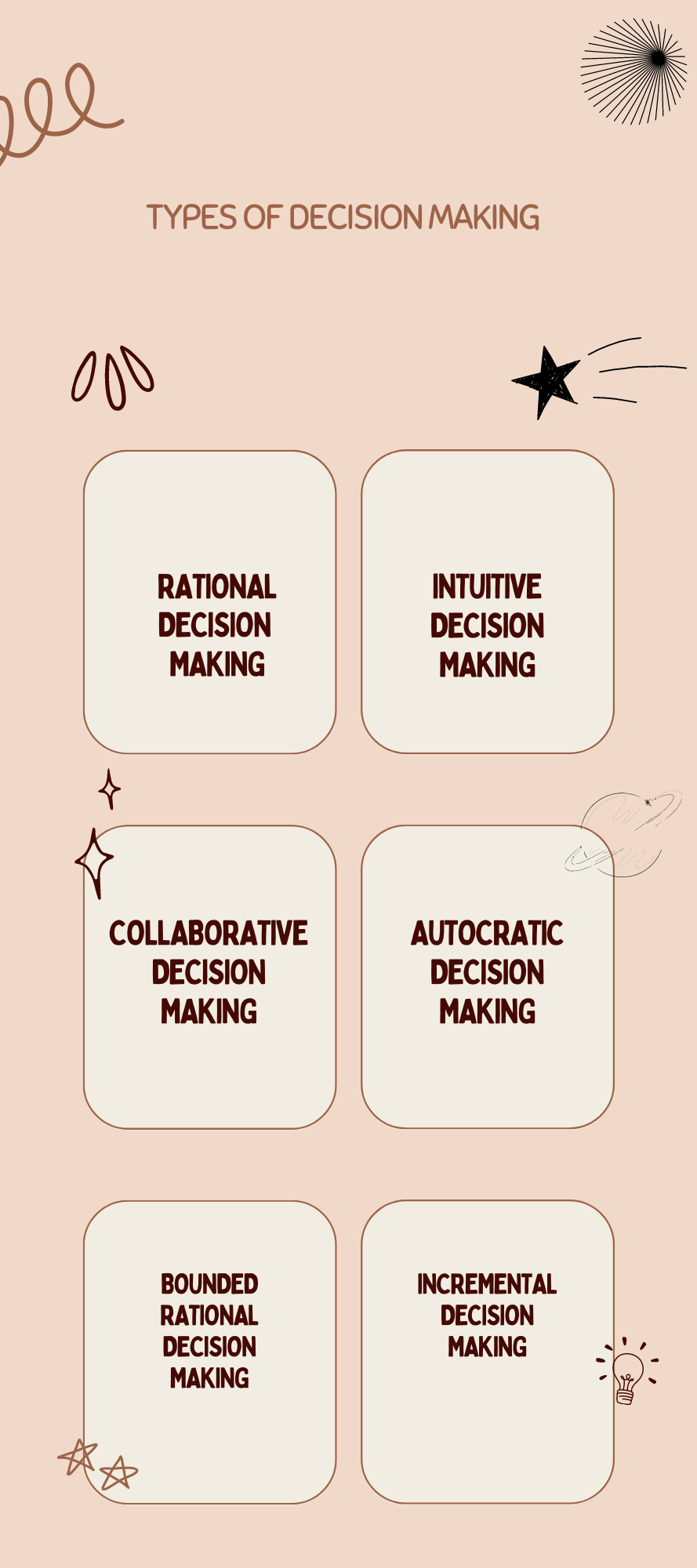Types of Decision Making

The process of making decisions is an inherent aspect of human life, a labyrinthine of countless choices that we encounter every day. These choices may seem trivial, like what to wear or what to eat, but they can also carry significant weight, such as selecting a career or choosing a life partner. Every decision we make shapes our future and carves out a unique path that defines who we are. The types of decision making utilized hinges upon various factors, such as the context of the situation and the information available to the decision maker. The selection of a decision making model can have a profound impact on the outcome of the decision.
Therefore, in this article, we will embark on a journey of exploration into the multifaceted world of decision making models. While some models may appear to be uncomplicated and require minimal reflection, others necessitate a more intricate analysis and a careful weighing of various factors. Some decisions may even require the acquisition of external advice from trusted sources. Understanding the different decision making models can empower individuals to make informed decisions, irrespective of the complexity of the situation.
Rational Decision Making
Rational decision making uses a methodical and logical procedure to ensure the best possible outcome. It involves identifying a problem and gathering relevant data. Alternatives are then chosen and evaluated. The best option is chosen, based on the analysis. This type of decision making is often used in business and management. Where decisions need to be based on facts and analysis and not emotions or personal biases. This is often referred to as the classical decision making model.
Intuitive Decision Making
Intuitive decision making is the opposite of rational decision making. It involves making decisions based on gut feelings and instincts rather than logical analysis. This type of decision making is often used in creative industries, where ideas need to be generated quickly and spontaneously. This quick decision making can also be based on extensive training like for policemen or pilots.
Collaborative Decision Making
Collaborative decision making is a group of individuals working together to make a decision. It involves considering the opinions and perspectives of everyone involved. The goal is to find a solution that works for everyone. This type of decision making is often used in teamwork-oriented environments. Everyone's input is valued.
Autocratic Decision Making
Autocratic decision making is a type of decision making by one person. That one person makes the decision without consulting anyone else. This type of decision making is often used in situations where time is of the essence. Quick decisions need to be made. However, this type of decision making can lead to resentment and a lack of buy-in from team members.
Bounded Rational Decision Making
Bounded rationality decision making where individuals make decisions based on their limitations. such as time, resources, and cognitive abilities. This is often used in situations where there are too many options to evaluate thoroughly. and individuals need to make quick decisions based on their limited knowledge.
Incremental Decision Making

Incremental decision making allows individuals or teams to focus on achievable milestones. This can help maintain motivation and momentum. It also allows for experimentation and learning along the way. This if accomplished as small decisions can be made and evaluated before moving on to the next phase.
However, it is important to note that this type of decision making may not be suitable for all situations. It requires a lot of time and effort. Decisions must be made consistently and systematically over an extended period. Additionally, some projects may require a more structured approach. They may have a clear end goal in mind.
Overall, incremental decision making is a powerful tool for managing complex projects. By breaking down the larger goal into smaller tasks, more informed decisions can be made. Focus can be on the end result, even when it may not be clear at the outset.
Conclusion
Decision making is an important skill that we all use in our daily lives. Knowing the different types of decision making can help us choose the right approach. There could be a need to make a rational decision based on data and analysis. Possibly a need to make an intuitive decision based on gut feelings. Understanding the different types of decision making can help us make better choices.
Intriguingly, the art of decision making is not a mere single occurrence, but rather a continuous and unending progression. With each decision, we accrue knowledge and learn from our blunders, which in turn enhances our decision-making processes.
Behold, a multitude of decision making paradigms exist, each replete with its unique characteristics, which can assist us in making informed and sagacious decisions, contingent upon the contextual variables and desired outcome.
Nevertheless, it is imperative to bear in mind that no decision-making approach is infallible, as each approach possesses its own idiosyncratic strengths and limitations. Therefore, it is of paramount importance to scrutinize and grasp the benefits and drawbacks of each approach, with the ultimate aim of selecting the most apropos one, predicated upon the exigencies of the prevailing circumstance.
Additionally, decision making is not always a lonesome pursuit, instead, it is often a collaborative effort. Decisions are often mired with many different stakeholders, each with their own individualized viewpoints and vested interests. Therefore, it is of paramount importance to involve all pertinent parties in the decision-making process to ensure that everyone's needs and opinions are given their rightful consideration.
Comprehending the various kinds of decision making and their distinguishing characteristics is a sine qua non. By using the most fitting approach, we can attain superior outcomes, rendering our decision making skills increasingly proficient and effective over time.
